What Is Eating My Bougainvillea Leaves?
Are you seeing damage on your bougainvillea leaves? Like something’s been chomping and munching away? I’m not talking little nibbles here and there but some serious feasting. I’ll tell and show you what it might be so you can identify the pest and take action.
I had 2 bougainvilleas in my Santa Barbara garden and 4 here in Tucson. I’ve learned a lot about them from working at a nursery but mostly by hands-on experience. They’re relatively easy to maintain except for the pruning which I happen to enjoy (yes, it’s true!) and you can’t beat them for an all-out show of color.
There are a few pests which attack them that I’ve skimmed over in previous bougainvillea posts and videos – so it’s time for more details.
Something eating my bougainvillea leaves! Hopefully, this will help:
3 Possible Pests Are the Culprits
Leaf Cutter Bee
This 1 is very easy to identify because you’ll see large even chomps, like half-moons, taken out of the sides of the foliage. You rarely see the leafcutter bee itself because it does its thing & then is gone. I never saw leafcutter bees in Santa Barbara but I did have them on 1 of my bougies in the spring. Nothing too bad but enough for me to notice. It’s now the very end of August & low & behold, I found 1 leaf with the evidence so I could show you.
What you should do as treatment: Nothing. These bees are beneficial pollinators & we need them. The leaves will grow back & by the way, they can’t be bothered with us humans so you don’t have to worry about being stung.
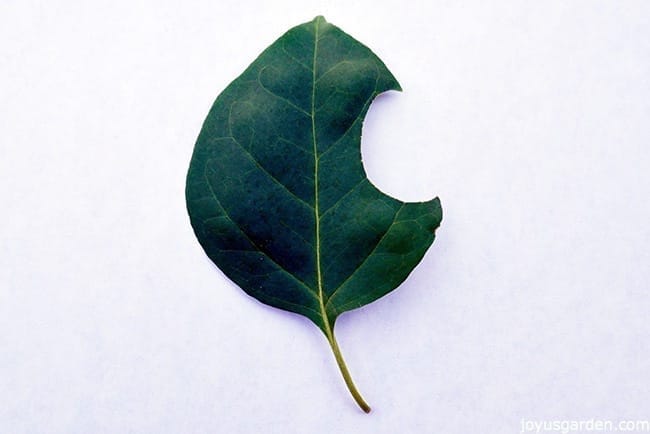
Evidence of leaf cutter bees. My how neatly they eat!
The next 2 pests are caterpillars which mean they eat like crazy. There are so many different types of caterpillars & they’re all hungry critters. The damage done by caterpillars can vary a bit but the treatment is generally the same.
All caterpillars (not only this one) eat & poop like crazy so the little black specks you’ll see on the leaves is their frass. And yes, caterpillar excrement has it’s own word.
Head’s up: Those black droppings are a sign caterpillars are in the house!
These are the 2 which I have seen on my bougainvilleas & have experience with:
Leaftier Caterpillar
I didn’t see these on my bougies in Santa Barbara either. They protect by getting on the under the leaves, rolling themselves up & then closing the leaves with silk threads. After the caterpillars have gone, you can unroll a leaf & still see evidence of the threads on the undersides. The damage to the plant is mainly at the end of the stems, as far as I can see anyway.
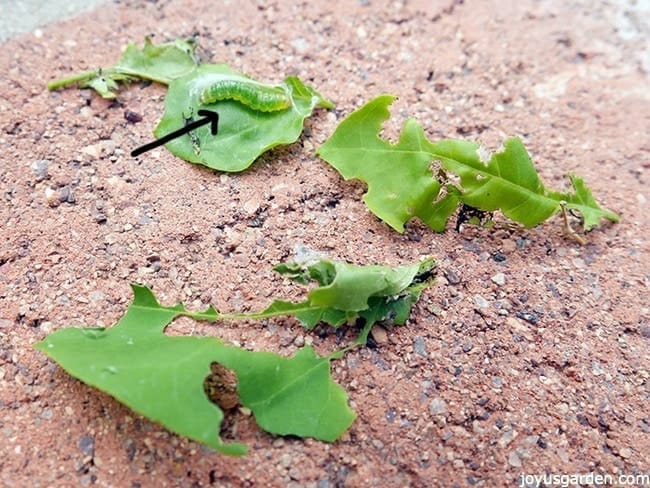
The leaftier caterpillar. You can see the webbing, like threads of silk, on the leaf behind the caterpillar which I unrolled.
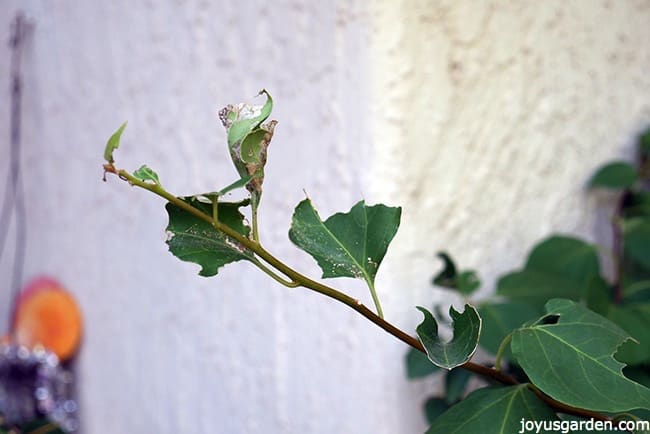
Here’s the damage done to the ends of the stems by the leaftier. You can see how 1 of the leaves is rolled up.
Bougainvillea Looper
These are the most common chewing pests which attack bougainvilleas that I know of. My Bougainvillea glabra had them big time in Santa Barbara every year come late July. They’re inch worms & can be brown to green to yellow. The loopers are hard to spot because they hang out under the leaves & do their feeding at night.
To me, they damage they do a lot more damage then the leaftier. The leaves get chewed extensively, both old & new, & can ultimately look like thin lace or be gone all together. I’ve never seen the looper cause leaf curl – please let us know otherwise if you have.
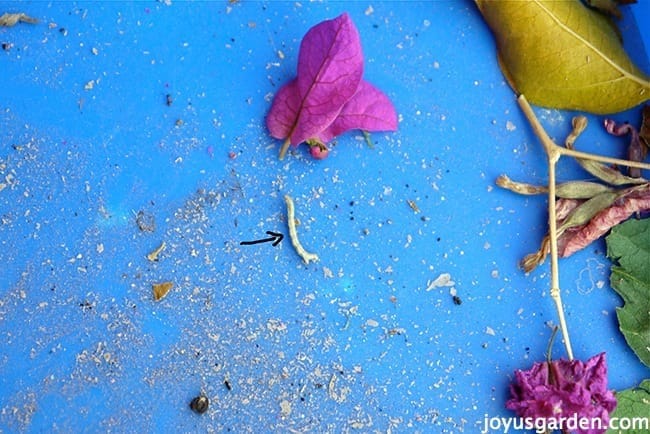
Here’s what the bougainvillea looper looks like; basically a small green inchworm. In the video, you can see the damage done to my mint by the cabbage looper. It looks similar to the damage this looper does.
Got questions about growing bougainvillea? We’ve got the answers!
Check out our in-depth Bougainvillea Guide, designed to help you grow this beautiful plant with confidence. Click the link to learn more. Happy growing!
Treatment For These Caterpillars on Your Bougainvillea Leaves
Head’s up: These pests don’t do any harm to or endanger the health of an established plant. All the damage is cosmetic. Bougainvilleas shed & regrow foliage a couple of times a year so you’ll see new leaves appear. On the other hand, a young plant could be susceptible to a bad infestation.
Here are your three options for treating these bougainvillea pests:
1.) Nothing
My bougainvilleas are well established & the damage doesn’t bother me, with either caterpillar. They hatch into moths, fly away & then I won’t see them again for a year. That being said, I will eventually prune off the damage done by the leaftiers. I would let the loopers be because my glabra was so full & dense it was hard to see unless I got close up.Remove them by hand.
2.) Remove the Pests by Hand
This is much easier to do with the leaftier as you can find them covered in silk inside the rolled up leaves during the day. The looper is much harder to find so this would be extremely labor intensive.
If you choose to control them with a spray, my word of advise would be to do it early on before the infestation gets worse. Reapply if the caterpillars return. Be sure to spray where the caterpillars to make it effective. Even though both of these sprays are reported to be non-harmful to beneficial insects, please be sure to spray around dusk when they aren’t as active.
3.) Spray the Leaves
BT is a naturally occurring bacteria which makes the caterpillars sick & ultimately causes them to die. It’s considered to be a natural pesticide. When I worked at a nursery, this is what we always recommended to control caterpillars. The other product would be neem oil. It’s reported to control caterpillars though I have no experience with this. Please let us know if you have.
Head’s up: caterpillars are treated differently so insecticidal soap & horticultural oil wouldn’t be effective at all – don’t waste your time.
I’ve noticed that these pests don’t seem to attack the flowers and that’s a very good thing. We want that explosion of color that only bougainvillea leaves can provide! By the way, none of my other plants have been attacked by these pests. Whether you choose to treat or not, do a little more research to see what’s best for you, the plant and the environment.
Happy gardening,

YOU MAY ALSO ENJOY:
- Things You Need To Know About Bougainvillea Plant Care
- Bougainvillea Pruning Tips: Everything You Need To Know
- Bougainvillea Winter Care Tips
- Pruning Bougainvillea In Summer To Encourage More Bloom
- Answering Your Questions About Bougainvillea
This post may contain affiliate links, you can read our policies here.
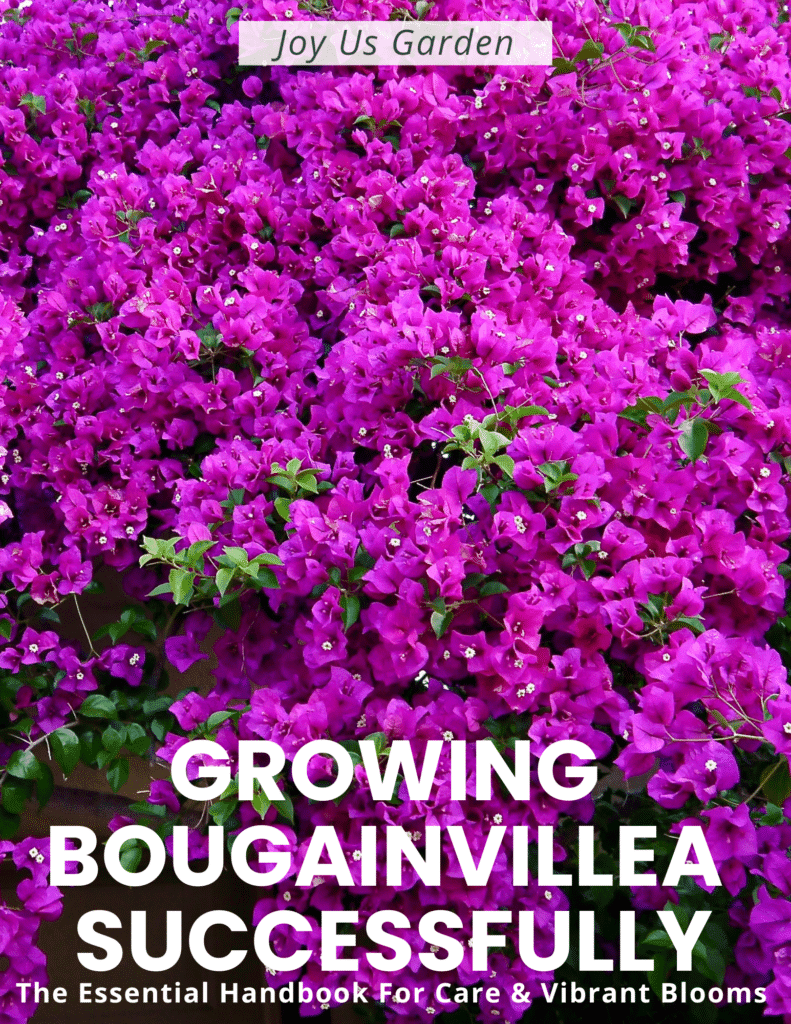

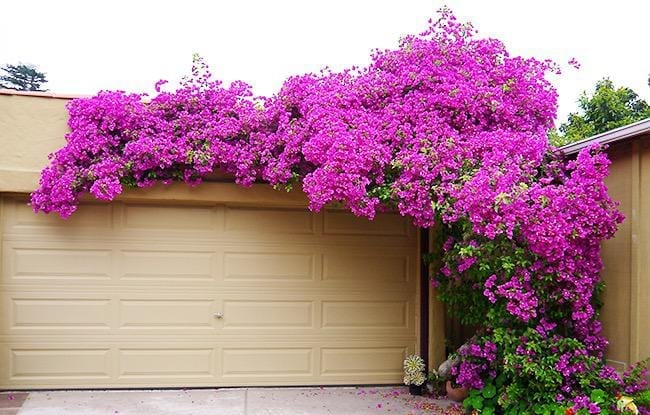
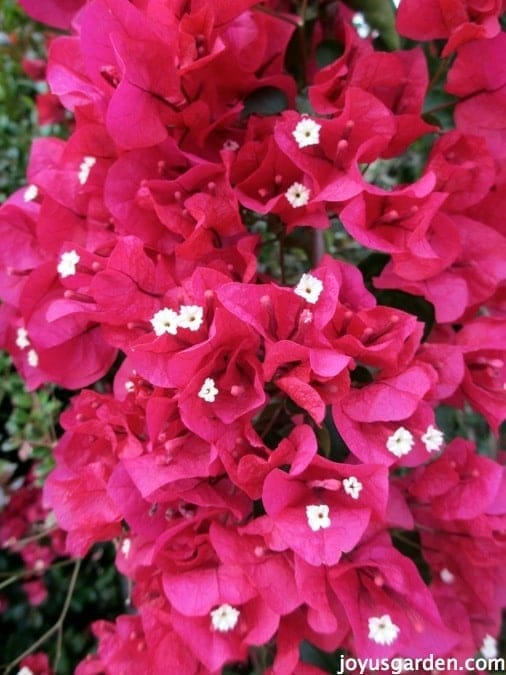

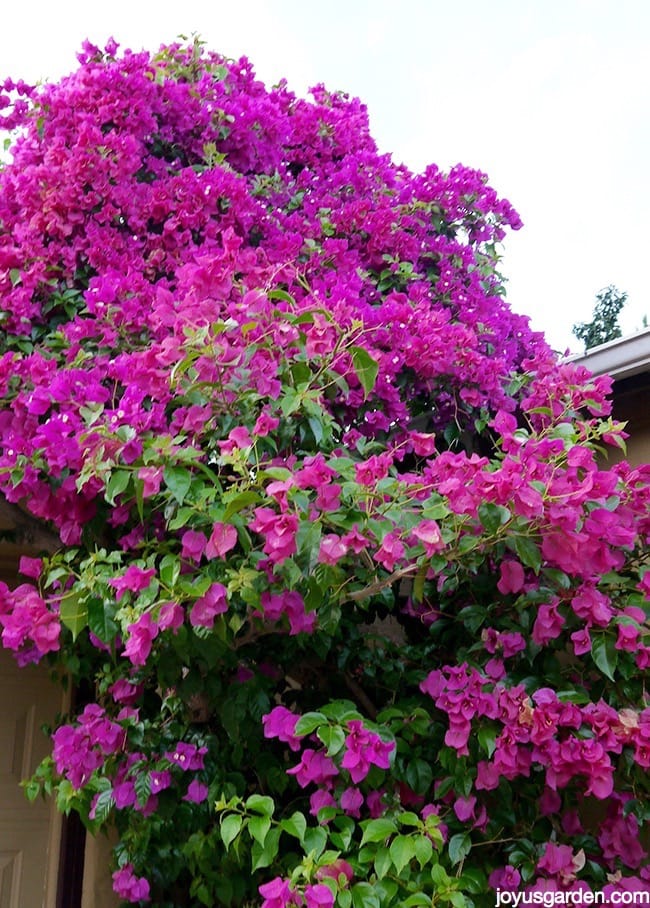
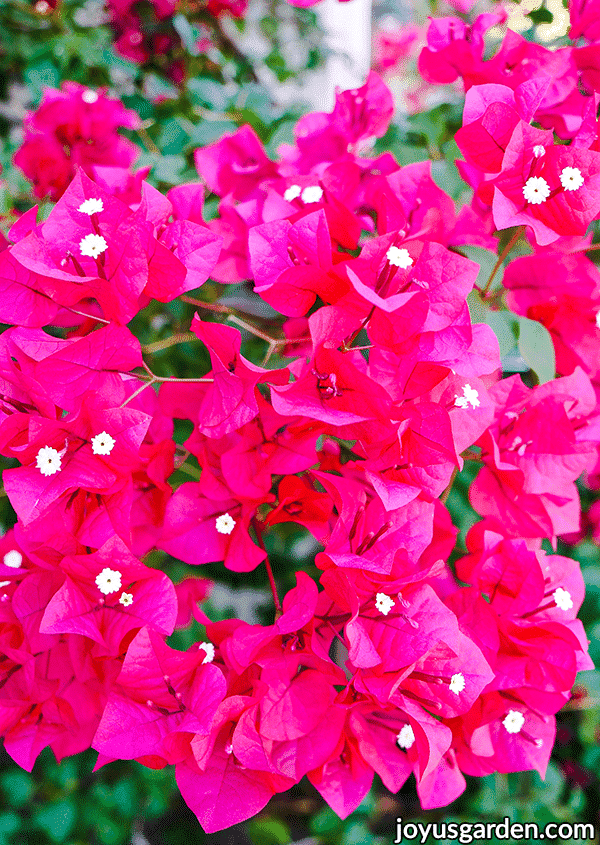
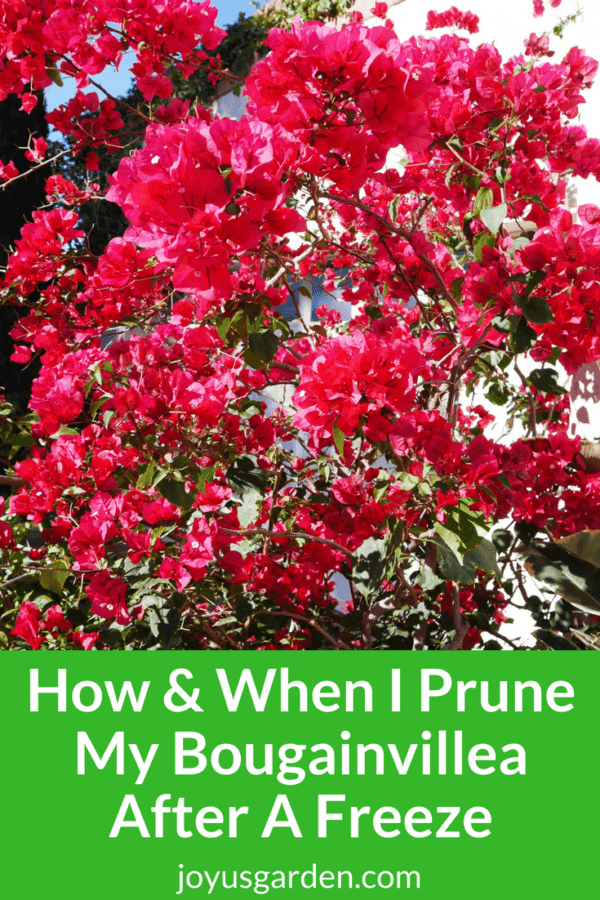

Great info Nell
Joan from Santa Barbara
Thank you Joan! good to hear from you. Nell
Hello Neil
I’m so glad to have found your post I am in the Gold Canyon area and have a bougainvillea for years and this year is the first time I encounter this problem… lots of butterflies and or moths as well.
Thanks to your post now I know what I am dealing with.
Hi Lolis – Yes, lots of butterflies this year which I’m thoroughly enjoying. I just let my bougainvilleas be & the caterpillars have left. They’re looking much better now that the temps have dropped to the 90’s! Nell
Hi Nell,
thank you for finally showing the Bougainvillea Leaftier. I have video of the Bougainvillea Looper if that would help you. I sent images of the Leaftier (before know what it is) to the LA County Dept. of Agriculture and they couldn’t identify it and suggested it was a juvenile looper, which is definitely not true and has entirely different shape and locomotion. I have an image of the juvenile which is entirely clear/translucent, if that would help you.
Thank you, Nell,
John
Hi John – Sure, that would be great. My bougies in Santa Barbara always got the looper. You can send the image to: info@joyusgarden.com with “looper image for Nell” in the subject line. Thanks! Nell
Thank you for this info! I just noticed my new leaves coming out on my plants …they went bare for a few weeks…and I sprayed with a pesticide …3 and 1 Ortho… because I noticed black specks on leaves and some eaten away… I came out today and there are black poop specks everywhere on the ground on the pot and leaves. Is it OK to spray again? Obviously I have caterpillars I guess… I am on the 8th floor and I have two beautiful Bouganvilleas (Spelling…) in pots… I’ve never noticed this so bad before
.. I have all this new leafage and I am afraid they’re going to destroy my plants completely. Any additional help you can give me would be greatly appreciated thank you! Maybe a special kind of pesticide? This book and bouganvilleas usually Bloom so radiant Li
Hi – I don’t use chemical pesticides so can’t recommend any. Most chemical & “safe” sprays don’t work on caterpillars. As I say in the post, any BT spray works on them. They’re hard to control because most feed & are active after dark. If you spray, be sure to get the undersides of the leaves. Nell
Hi,
I live in Cape Town, South Africa. At the moment we are going through
a drought. I have a bougainvillea growing in a tub. It isn’t growing very
well and I couldn’t understand why. This afternoon I found the culprit.
There were 5 doves sitting round the tub eating the leaves. I have never
come across this before. Could it be the drought and everything is very
dry. There is water available for them.
Any comments,
Regards,
Jean Strachan
Hi Jean – I’ve heard about your drought. I have lots of doves around my house here in the Arizona desert & none of them eat my bougainvilleas. I do know that some birds will eat the caterpillars which feed on the leaves. Not sure if doves do. Nell
Something is killing my huge bougainvilleas by destroying the woody stems, Not any wildlife like deer here in san diego city, There are various birds rousing in the vines like sparrow finch and doves, I have never seen the birds pecking the vines and no leaf damage, Have wondered it possibly insects in or on the stems that cause birds to peck them? or would birds be shredding the vines for any other reason? Is there some insect that attacks the woody stems? The damage is on going for years and extensive. There is much debris, shredded parts of stems Now the same damage is happening to the top fronds on a huge date palm i planted from seed 25 yrs ago, eating out the central channel of the leaves, It is destroying top of the tree and i fear will kill the tree if it tops it off by killing new fronds. I have never seen any insects on either plant no beetles or caterpillars evident or leaf damage. Help? direct me what to research please.
Hi Fortune – You could try your local ag extension office & seek their help as to what’s going on with your bougainvillea & date palm. http://cesandiego.ucanr.edu/ Nell
Hello Nell, I live in Playa del Carmen, (south of Cancun, Mexico). Of course, we have warm to very hot wheater, I have 2 Santa Rita plants, in large pots in the balcony, 4 flr…
One is doing fantastic, growing up from a small branch with roots I found when walking.Lucky me.
The other one we bought it from a nursery.. Its “flowers” are mixed and white color.. But… the green leaves are showing signs of a pest…
I found brown little circles plus some elongated holes, like if the circle has expanded…
Could you please advise what can I do to eliminate whatever is that is causing the damage.
I would very much appreciate your answer, on line or by e-mail.
Thank you,
Dora Sohnlein
Hi Dora – I’ve been to Playa del Carmen years ago. The pests I’m familiar with that attack bougies are in the post. The bougainvillea looper is the most common. There’s also a bougainvillea caterpillar moth but I’ve never seen it before. Grasshoppers can also attack bougainvilleas & voraciously devour leaves & flowers. I’d check at a reputable nursery & see if there’s another pest specifically to your area which could be attacking them. Nell
Hi, I have sent you a picture of my Bouganville’s infested leaves.. thank you…
Dora S.
I saw them Dora & answered your previous comment. Nell
I have the black specs, too, just like the person who posted. I ordered the BT for the caterpillars from you Amazon link- thank you so much.
You’re certainly welcome Katie. My bougainvilleas have them this year but not as bad as last year. They come hand in hand with the plant! Nell
Hi Nell, is BT a brand or just a generic ? Do you know a BT spray by name ? Can I find’t at Home Depot for example? Many thanks !!!!
Hi Victoria – BT is an ingredient (Bacillus thuringiensis) so they are different brands that contain it. It’s quite common so someone at HD will be able to help you find it. Nell
Hi Nell,
Great information. I have beautiful white bougainvilleas in my south Florida yard. I have been told, the white variety has a bigger issue with caterpillars than other colors. Is this something you have seen?
Thanks,
Thank you Roxane. I haven’t heard that about the white bougainvilleas. My Rainbow Gold Bougainvillea got good & chewed last season but came back beautifully. My Barbara Karst is much less attacked. Could be because it gets more hot sun. Nell
Live in Sun City AZ and my bush is 6 years old. Something is eating the branches. Looks like they have been cut. It only happens over night.
Lorraine – It’s most likely the leaf cutter bee. Nell
Hi Nell! I recently started outdoor gardening and have loved reading your posts. I read up on bougainvilleas before planting mine and followed your advice to keep it in the nursery pot. I think I have a rosenka (it wasn’t labeled). The blooms have all fallen off and the leaves are all curled. I noticed in the top photo on this post you have something that looks similar, same colors and curled leaves, though my leaves are more curled. I have no idea what I’m doing wrong or how to get my bougie looking healthier. The leaves are green and not dry, and I haven’t noticed any particular pests, though we have lots of spiders and they have made their ways into some of the leaf curls. I don’t see signs of a nutrient deficiency, but maybe I don’t know how to spot it. I’ve fed it orchid food 30-10-10 a couple of times in the past 6 weeks. Thank you for putting this wonderful and informative blog together!
Hi Carina – You’re very welcome! Often you don’t see a pest, only the effects. With a 30-10-10 fertilizer, the nitrogen is too high is ratio for a bougie. I’ve done lots of posts which you can check here: https://www.joyusgarden.com/category/outdoor-gardening/bougainvillea/ Nell